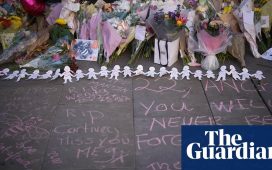“You’re going to see bizarre things you would never want to see in your child’s school,” said Lavarello, executive director of the School Safety Advocacy Council.
Experts call it “school security theater” — the idea that if a school system buys enough technology or infrastructure, it can keep its children safe from the horrors of a gunman.
In reality, many say, strong relationships between students and staff and robust staff training to influence what may seem like small decisions by school personnel may be at least as important, if not far more.
In the aftermath of another school shooting, school leaders, teachers, parents and others are debating, yet again, how the next one might be prevented. The national debate revolves around policy decisions: Should gun sales be restricted? Should teachers be armed?
For school systems, though, the questions often come down to what to buy, who to hire and how to prepare their staffs.
One security measure that enjoys broad consensus is keeping all external school doors locked, and forcing visitors to enter schools through a single entry point. This is a low-hanging-fruit solution that many districts have adopted.
But in Uvalde, Tex., officials say the gunman entered a back door that had been propped open by a teacher.
Better training might have led that teacher to think twice, experts say.
“We are throwing billions of dollars at security hardware, access control on doors, single point of entry, cameras, metal detectors in some places,” said Kenneth S. Trump, president of National School Safety and Security Services. “Any security technology is only as good as the weakest human link behind it and we are not focusing on training our people.”
On paper, the Uvalde school district had a robust security plan in place. That included dedicated police officers, threat assessment teams, a visitor management system, perimeter fencing, alarm systems, security cameras, radios and trainings for students and staff. It also tells teachers to keep classroom doors closed and locked at all times. But that doesn’t mean it was properly implemented.
Trump often serves as an expert in court cases stemming from school security failures. The common thread, he said, is allegation of failure by people, policies and procedures. Technology, he said, “only works if it’s properly and consistently implemented.”
Lavarello said he was consulting on security with a school district that had recently spent more than $350,000 on excellent exterior door locks. He told them they wouldn’t keep someone out and offered to test the system: “I’ll be in your school in five minutes,” he said. He then went around the building to a locked door, knocked and a group of students let him in. “I didn’t look like a threat and they’re nice kids.”
Another challenge: Most school shooters are students or others who are allowed to be in the building, not random strangers, so entry-point gateways may not be effective in stopping them. In Oxford, Mich., last year, a 15-year-old student was already in the building for school when authorities said he shot and killed four classmates.
As a result, many security experts and educators point to a solution that is decidedly low-tech: the relationships students develop with teachers, counselors, even cafeteria workers — people who might notice when something is off, staffers whom students confide in when they see a classmate whose behavior scares them.
In Uvalde, Riedman said, better prevention might have included spotting warning signs around the shooter well before the massacre, said David Riedman, lead researcher on the K-12 School Shooting Database. “We have not made that commitment to crisis intervention when people are on that path,” he said.
“There are warning signs that are occurring and people are missing those warning signs because they don’t know what they are or they don’t know what to do about it,” he said.
When asked what he thinks is most important to preventing acts like this, Adam Lane, principal of Haines City High School in Polk County, Fla., did not hesitate: relationships, he said.
Lane said that in addition to classes, every one of his 3,000 students is connected to at least one educator through a sports team or one of 37 clubs on campus. Students are required to belong to at least one, in part to connect them with a caring adult.
“You have to start with the internal relationship building,” he said. “We really care for each other.”
Educators have long argued that more resources are needed to support students’ social emotional needs, and that’s been particularly true during the pandemic, when violence has been at a high and student mental health more strained than ever.
“We really need to fund counselors in schools,” said James Dempsey, professor of criminal justice at Metropolitan State University in St. Paul, Minn., and co-founder of the Violence Project, a study of mass shootings in the United States. “Reduce class sizes so kids feel seen, and then we can observe warning signs and recognize them when they are right there in front of us.”
He added: “It improves educational outcomes, too.”
That’s not to say that technology does not also serve a role. There’s considerable consensus, in particular, around lower-tech ideas such as locked doors and fences around a school perimeter, both of which could slow down if not halt a gunman.
“If you want the No. 1 thing? Locked doors, locked classrooms,” said Elizabeth Brown, principal of Forest High School in Marion County, Fla. She took over as principal 45 days after a school shooting incident.
Experts also point to communication tools, such as handheld radios that allow school personnel to exchange information quickly among themselves and law enforcement.
Lane, the principal in Polk County, Fla., said that in addition to relationships, he relies on a network of dozens of cameras around the campus. Experts say one problem with cameras is they are sometimes installed but then there is no funding to maintain them. But Lane said he is able to replace broken equipment and add new cameras every year.
He said it used to be that anyone could enter the school. Now, visitors must talk to someone in the office, who can see who is standing outside and make an assessment. Sometimes, he said, parents can drop items off for their children and not even have to enter the building, reducing risk.
Riedman said there are only two American institutions that have truly dedicated themselves to a prevention mission: the Transportation Security Administration, which screens airline travelers, and the U.S. Secret Service, which protects the president and other high-profile leaders.
“In airports we’ve decided we can invest hundreds of billions of dollars into making sure that absolutely no weapon or explosive gets onto an airplane. The baseline is zero,” he said. “We’ll spend any amount of money to get there.”
If the president is speaking at a local school, there will be a phalanx of law enforcement and bomb-sniffing dogs and a tight security perimeter.
That, he said, is not viable at a school.
“The school’s not a fortress,” he said. “It’s an operation that has lots of things going on all the time.”






